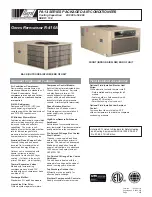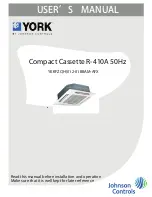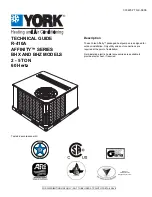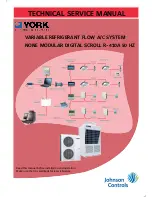
26
English
10. Air tight test and vacuum drying
•
After finished piping work, carry out air tight test and vacuum drying.
NOTE
• Always use nitrogen gas for the air tightness test.
• Absolutely do not open the stop valve until the main power circuit
insulation measurement has been completed. (Measuring after the
stop valve is opened will cause the insulation value to drop.)
<Needed tools>
Gauge manifold • To prevent entry of any impurities and insure
sufficient pressure resistance, always use the
special tools dedicated for R410A.
• Use charge hose that have pushing stick for con-
necting to service port of stop valves.
Charge hose
Valve
Vacuum pump
• The vacuum pump for vacuum drying should be
able to lower the pressure to 500 microns
(66.5 Pa).
•
Take care the pump oil never flow backward into
the refrigerant pipe during the pump stops.
<The system for airtight test and vacuum drying>
•
Referring to the figure below, connect a nitrogen tank, refrigerant
tank, and a vacuum pump to the outdoor unit.
The refrigerant tank and the charge hose connection to service port
of all valves in the figure below are needed in
14. Charging refrigerant on page 29.
1
2
3
4
5
6
A
B
8
7
9
9
10
12
11
13
14
1 Gauge manifold
2 Nitrogen
3 Measuring instrument
4 Refrigerant R410A tank (siphon system)
5 Vacuum pump
6 Charge hose
7 Gas pipe stop valve
8 Liquid pipe stop valve
9 Outdoor unit
10 To indoor unit
11 Valve
12 Field piping
13
Gas flow
14 Stop valve service port
A Valve A
B Valve B
NOTE
• The air-tightness test and vacuum drying should be done using the
service ports of gas pipe and liquid pipe stop valve. See the [R410A]
Label attached to the front panel of the outdoor unit for details on
the location of the service port (see the figure below).
[R410A] Label
•
See 14.3. Method for adding refrigerant on page 31 for details on
handling the stop valve.
• The refrigerant charge port is connected to unit pipe. When
shipped, the unit contains the refrigerant, so use caution when at-
taching the charge hose.
<Air tight test>
Pressurize the gas pipe and liquid pipe from the service ports of each
stop valve to 550 psi (3.8 MPa) (do not pressurize more than 550 psi
(3.8 MPa)). If the pressure does not drop within 24 hours, the system
passes the test.
If there is a pressure drop, check for leaks, make repairs and perform
the air tight test again.
<Vacuum drying>
Evacuate the system from the gas pipe and liquid pipe stop valve ser-
vice ports by using a vacuum pump for more than 2 hours and bring
the system to 500 microns (66.5 Pa) or less. After keeping the system
under that condition for more than 1 hour, check if the vacuum gauge
rises or not. If it rises, the system may either contain moisture inside or
have leaks.
NOTE
During the rainy season, moisture might enter the piping. If
working during a rainy season and the work takes long enough
for condensation to form inside the pipes, take the following
precautions:
After evacuating the system for 2 hours, pressurize the system to
375,000 microns (0.05 MPa) (vacuum break) with nitrogen gas and
evacuate the system again using the vacuum pump for 1 hour to 500
microns (66.5 Pa) or less (vacuum drying).
If the system cannot be evacuated to 500 microns (66.5 Pa) within
2 hours, repeat the operation of vacuum break and vacuum drying.
Then, after leaving the system in a vacuum for 1 hour, confirm that the
vacuum gauge does not rise.
01_EN_Main_VRV6_HP_IM.indd 26
01_EN_Main_VRV6_HP_IM.indd 26
2022/11/17 16:07:33
2022/11/17 16:07:33
















































